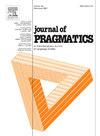A pragmatic analysis of discourse marker 넵 neyp ‘yep’ in Korean computer-mediated communication
IF 1.7
1区 文学
0 LANGUAGE & LINGUISTICS
引用次数: 0
Abstract
This study explores the diverse functions and contextual use of the Korean discourse marker 넵 neyp ‘yep’ in online conversations, highlighting its adaptation within digital communication contexts. Using data from the National Institute of Korean Language (NIKL) Online Conversation Corpus, the study identifies eight primary functions of 넵 neyp, namely, affirmation, acceptance, agreement, confirmation, acknowledgment, continuer, response to summons, and other-initiated repair. The findings reveal that 넵 neyp is not just a simple substitute for “yes,” but a versatile tool for managing conversational flow, building social rapport, and compensating for the absence of non-verbal cues in text-based interactions. By examining these functions, the study contributes to a deeper understanding of how linguistic practices evolve to meet the communicative demands of digital environments, shedding light on the interplay between technology, language, and social interaction. Additionally, the analysis shows that 넵 neyp is more frequently used in online conversations, in large part due to the consonant ㅂ (p), which conveys emphasis and engagement, fostering camaraderie and encouragement among participants. Furthermore, 넵 neyp maintains a polite and approachable tone, making it ideal for casual, professional, and semi-formal interactions, especially with strangers. This study offers insights into how digital environments shape language practices and highlights their role in bridging social distances in online contexts.
韩语计算机媒介交际中话语标记词“是的”的语用分析
本研究探讨了韩语语篇标记词“是的”在在线对话中的不同功能和语境使用,强调了它在数字通信语境中的适应性。该研究使用了国立韩国语言研究所(NIKL)在线对话语料库的数据,确定了neyp的八个主要功能,即:肯定、接受、同意、确认、确认、继续、响应召唤和他人发起的修复。研究结果表明,neyp不仅仅是一个简单的“yes”的替代品,而且是一个管理会话流、建立社会关系和弥补基于文本的交互中缺乏非语言提示的多功能工具。通过研究这些功能,本研究有助于更深入地了解语言实践如何演变以满足数字环境的交际需求,揭示技术、语言和社会互动之间的相互作用。此外,分析显示,neyp在在线对话中使用得更频繁,这在很大程度上是由于辅音(),neyp传达了强调和参与,在参与者之间培养了友情和鼓励。此外,neyp保持了一种礼貌和平易近人的语气,使其成为休闲,专业和半正式互动的理想选择,特别是与陌生人。这项研究提供了数字环境如何塑造语言实践的见解,并强调了它们在网络环境中弥合社会距离的作用。
本文章由计算机程序翻译,如有差异,请以英文原文为准。
求助全文
约1分钟内获得全文
求助全文
来源期刊

Journal of Pragmatics
Multiple-
CiteScore
3.90
自引率
18.80%
发文量
219
期刊介绍:
Since 1977, the Journal of Pragmatics has provided a forum for bringing together a wide range of research in pragmatics, including cognitive pragmatics, corpus pragmatics, experimental pragmatics, historical pragmatics, interpersonal pragmatics, multimodal pragmatics, sociopragmatics, theoretical pragmatics and related fields. Our aim is to publish innovative pragmatic scholarship from all perspectives, which contributes to theories of how speakers produce and interpret language in different contexts drawing on attested data from a wide range of languages/cultures in different parts of the world. The Journal of Pragmatics also encourages work that uses attested language data to explore the relationship between pragmatics and neighbouring research areas such as semantics, discourse analysis, conversation analysis and ethnomethodology, interactional linguistics, sociolinguistics, linguistic anthropology, media studies, psychology, sociology, and the philosophy of language. Alongside full-length articles, discussion notes and book reviews, the journal welcomes proposals for high quality special issues in all areas of pragmatics which make a significant contribution to a topical or developing area at the cutting-edge of research.
 求助内容:
求助内容: 应助结果提醒方式:
应助结果提醒方式:


